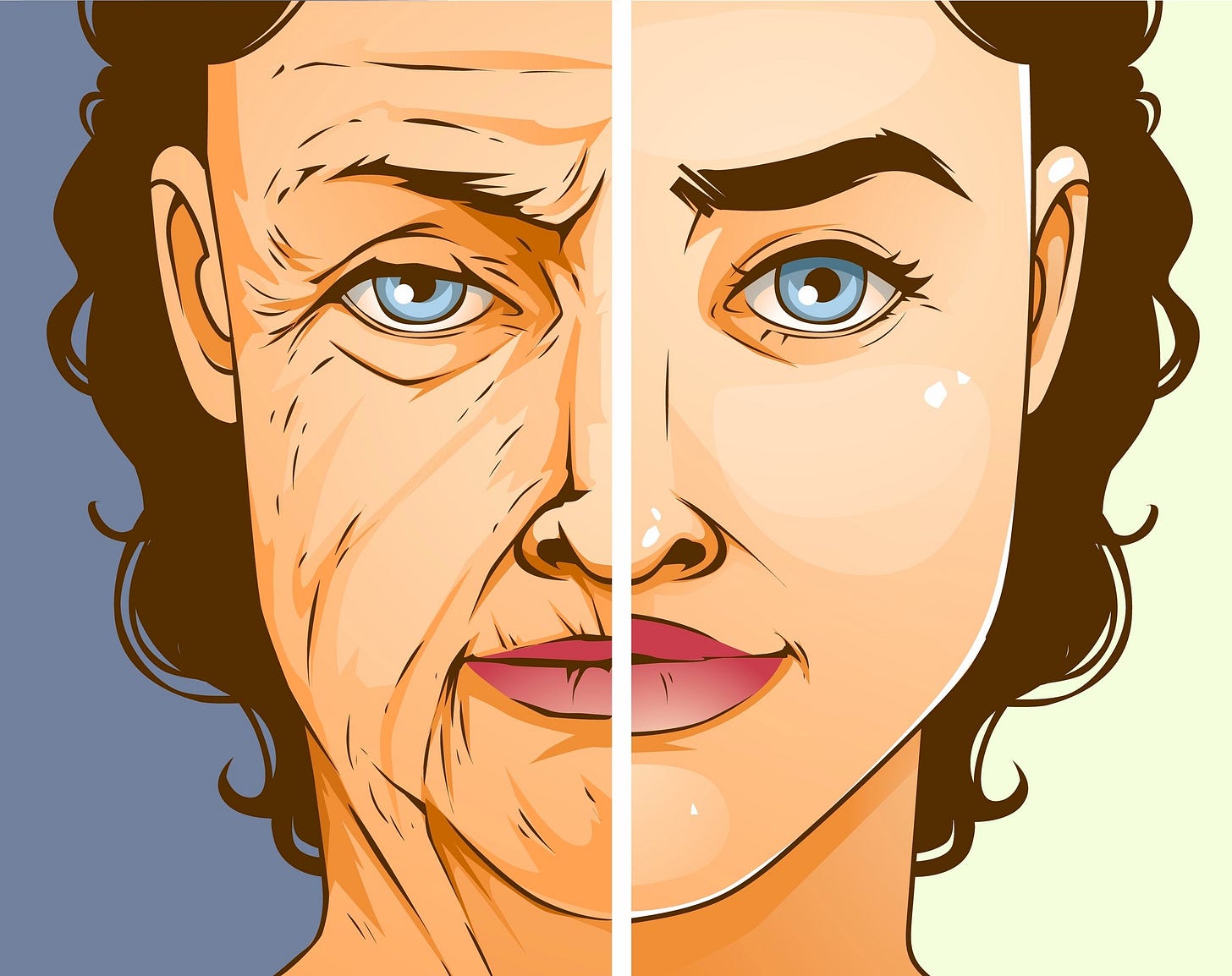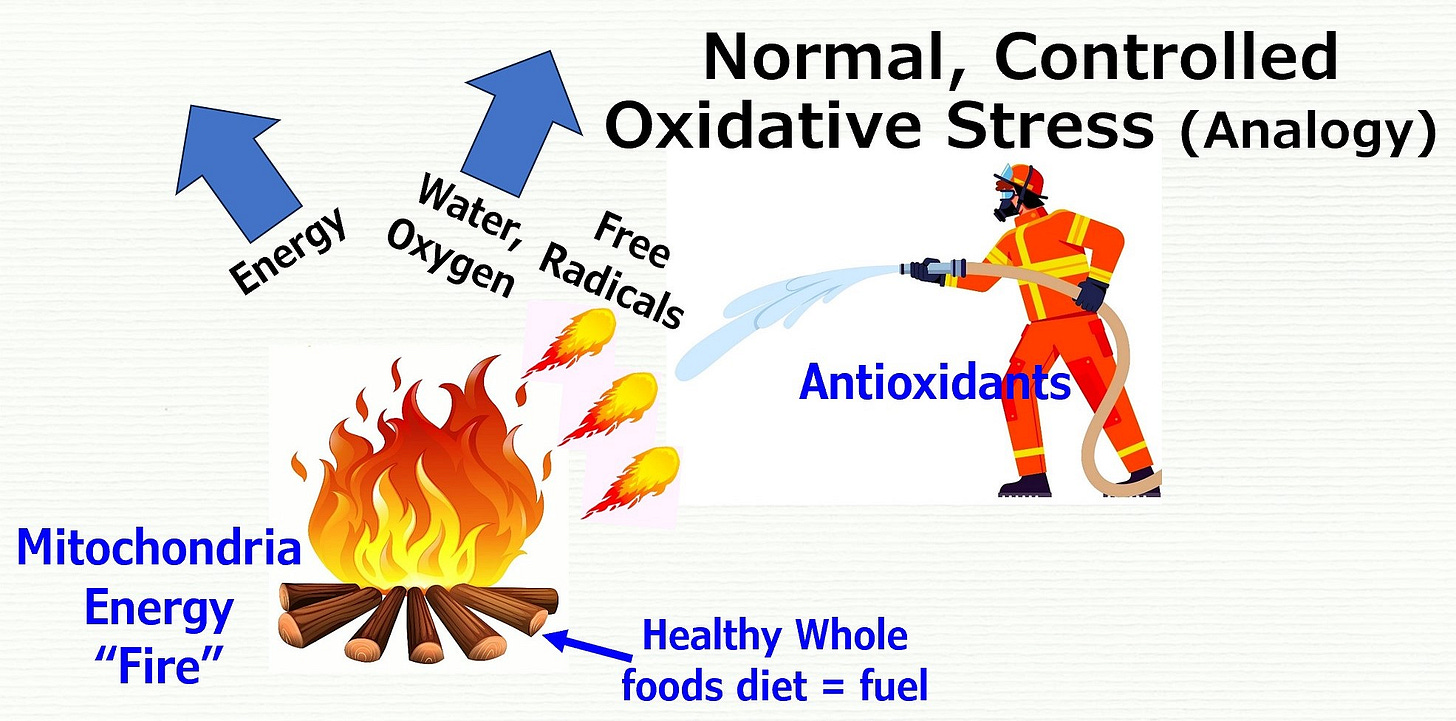The Greatest Hidden Threat: Part 1
How oxidative stress from seed oils can destroy your body
What is the difference between the “young” face (the right half of this image) and the “old" face? Why does a child have more energy than his or her grandfather? Instead of “old age,” a primary cause is oxidative stress, a chemical process that happens inside each of your cells every second. Some amount of oxidative stress is natural and even helpful, but if it becomes excessive and unbalanced in your body, this process will lead to damage and disease. It may even be the primary driver of aging.
How does this get out of hand? Our diet, lifestyle, and chemical exposure are the culprits, and we will discuss a few of these.
From the Wellness Series and my articles, you are already aware of many threats to your health from foods in our industrialized society—sugar, grains, alcohol, and chemicals in food, plastics, and pollution. But another threat is hidden in a substance that you eat every day without thinking yet belongs at the top of your list of dangerous, deadly foods. Some of the research being conducted today even suggests it may be more hazardous to your health than refined sugar!
Except for functional medicine doctors studying the latest research on this poison we eat, most health experts, nutritionists, health care professionals, and others are unaware of this threat. As we would expect, the Big Ag companies and food manufacturers that participate in this multi-billion-dollar industry by growing, selling, or using these products ignore or actively diminish the danger.
What is this poison? Highly refined, industrially produced seed oils, also called “vegetable oils,” even though no vegetables are involved. Part 2 of this article will focus on how seed oils became so prevalent in our food supply and what you can do about it. But first, we need to understand why seed oils and some other foods are responsible for causing oxidative stress and how they damage your body.
What is a “seed oil?”
You may not be familiar with this term that describes highly processed oils used for cooking, frying, and as an emulsifier to stabilize most processed food. In fact, food manufacturers love it because of the low cost, long shelf life and neutral flavor, including it as an ingredient in 80-90% of all ultra-processed foods. Included in this term is anything called “vegetable oil,” butter substitutes, and industrially refined oils, especially canola, soybean, corn, sunflower, safflower, rice bran, grapeseed, and cottonseed oil. Because of their chemical structure, all seed oils cause excessive oxidative stress.
What is oxidative stress?
Despite the critical nature of this process happening in your cells every second, I neglected to cover it thoroughly in my last Wellness Series presentation (I will correct that soon). Instead, I emphasized insulin resistance, which may be our biggest threat because of our carb-aholic diet (see my article on “The Train Wreck - Insulin Resistance”). As we will see later, both processes are connected.
Oxidative stress endangers your health and life, but the understanding of this threat and the connection to chronic disease has a shorter history than insulin resistance. Also, the complexity of the process and its seemingly benign or “natural” impact (like the wrinkles on the left half of the image above) reduce its presence in popular literature. But do not worry—I will simplify my explanation to make it both interesting and understandable. Analogies are never perfect, but helpful.
One way to talk about oxidation is with the picture above. If you have ever let a cut apple or banana sit on the counter too long, you know it starts looking like the one on the right. It might remind you of the left half of the face image above—with good reason. Both are products of oxidation. Another analogy is rusting; in a way, your body is “rusting” as you age.
But to better capture the dangers of excessive oxidative stress, I will use a campfire analogy to describe what happens in your body. This seems appropriate because combustion is one of the most familiar forms of oxidation.
In each of your trillions of cells, you have several hundred or thousand mitochondria that are always making energy to keep your body functioning. Thinking, breathing, moving blood, triggering hormones, digesting food, and a lot of other stuff takes energy even when it feels like you are doing nothing. Without this process working well, all the time, you get sick or die.
The fire represents one of the mitochondria energy factories that burns the “fuel” you eat to create “heat” (energy), with oxygen and water as byproducts. But the system is not perfect and often produces free electron molecules that escape and could cause problems shown as flying hot embers. These represent free radicals, troublemakers that cause problems if not neutralized by the cell. Fortunately, every cell creates and stores antioxidants just for this purpose like the fireman with the hose.
Now I know what you are thinking—I will just take lots of antioxidants in supplement form to keep my mitochondria healthy. Nope. It doesn’t work that way. Many problems prevent these supplements from having any significant impact on our cellular biology. Most are worthless. Instead, you can create healthy mitochondria by eating real, whole foods, especially those with color (beets, carrots, greens, berries, etc.) that also may have some antioxidants your body cannot make by itself.
Getting back to this process, oxidative stress does have a positive role. All acute inflammatory healing responses in your body begin with the oxidation of fatty acids in your cell membranes. This triggers acute inflammation that heals a wound or defends against an infection. Balance is the key to prevent this healing, positive impact from becoming chronic inflammation.
The picture below shows how a finely tuned, healthy energy creation system gets unbalanced.
The small, steady fire creating clean energy doesn’t burn well if you feed it processed food, sugar, or other carbs. Things become unbalanced. Eating seed oils is like pouring gasoline on the fire, also creating more free radicals than the cell can neutralize. The scary part is this: this imbalance starts a chain reaction, like dominos falling, disrupting everything the cell is trying to do. Free radicals create a firestorm of toxic chaos that overwhelms and destroys the entire cell (the explosion in the image). This creates serious problems leading to cell death, lots of carnage in your body, and garbage left behind.
What happens next?
The words “finely tuned” and “imbalance” were carefully chosen. Your body is an amazing, complex organism that was designed over three hundred thousand years to survive dangerous threats, but not designed to handle the poisons modern man can dream up. Many of these food substances, like refined sugar, grains, refined seed oils, and fast food, create the imbalance described above.
An out-of-balance system depletes the antioxidant storage, weakens your defenses, lowers your energy, and leads to chronic inflammation. Most chronic diseases, including heart disease, diabetes, Alzheimer’s, arthritis, fatty liver disease, and hundreds of others, have their root in inflammation. Many of the foods, toxins, and poor lifestyle choices discussed in the Wellness Series and in other articles on this site trigger excess oxidative stress, but seed oils deserve special attention.
What is so different about seed oils?
The secret about seed oils is this: they have silently created a massive health crisis under our noses. First, because of their unique chemical structure as an industrialized, highly refined polyunsaturated fat, they create more oxidative stress damage than any other food. Second, the downstream effects of seed oils are more extensive and deadly than anyone dreamed of a couple of decades ago. Third, this toxic food substance has taken over our diet while most thought it benign or even healthy. Our consumption of these industrialized oils has crept up from zero to one-third of our total calories in the last fifty years and still, few are raising an alarm!
Multiple research studies have confirmed the negative impacts on your body from seed oils:
Produce too many free radicals, creating excessive oxidative stress. Your body was never designed to handle this artificial, human-created substance that is highly unstable in your body.
Lead to chronic inflammation, which is directly triggered by excessive oxidative stress and is a primary cause of most chronic diseases.
Reduce the energy output of your mitochondria; it is a much less efficient fuel source. Because the brain uses more energy than any other single part of your body, seed oils can affect brain function, leading to brain fog, fatigue, or weakness and long-term mental decline. As the least efficient of all the fats we consume, seed oils also force our body to pull more glucose from our blood, raising our insulin level and causing insulin resistance.
Increase insulin resistance by increasing blood glucose (and insulin) between meals leading to diabetes and many other downstream chronic diseases.
Change your stored body fat composition, dramatically increasing the levels of polyunsaturated fatty acid (PUFA) content, which is more inflammatory and harder to lose. Research on this issue indicates that the higher PUFA fat on our bodies has accelerated the obesity crisis despite our decreased sugar consumption.
This last impact on our body is really shocking—a food substance we take for granted has been dramatically changing our body composition during the last 70 years. Over time, seed oils fundamentally change the fat stored on your body. By combining multiple studies involving adipose tissue samples taken from adults over many years, the average PUFA content in our cells has gone from 1-3% in 1958 to over 21% in 2008, dramatically more than our ancestors. We have quadruple the amount of PUFA fat our bodies are designed to handle! This type of fat creates more chronic inflammation in your body and results in many of the downstream results described above.
As Dr. Shanahan says, “a diet full of vegetable oils makes oxidative stress, and chronic disease, inevitable.”
Part 2 of this article will explain how we got into this mess and what you can do about it. See you next week. Thanks for reading!
Note: Based on the recent writings of some of the top functional medicine doctors, including Drs. Catherine Shanahan (Dark Calories), Georgia Ede (Change Your Diet, Change Your Mind), Michael T. Chang (Mitochondrial Dysfunction), David Perlmutter (Grain Brain), and Michael Greger (How Not to Die).






